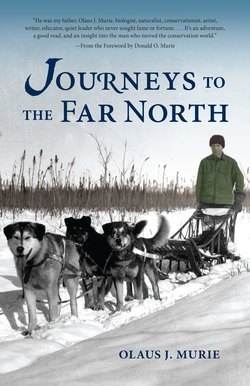Читать книгу Journeys to the Far North - Olaus J. Murie - Страница 6
На сайте Литреса книга снята с продажи.
ОглавлениеFOREWORD
by Donald O. Murie
My mother, Margaret (Mardy) Murie was invited to attend a ceremony at the White House on January 15, 1998. She was ninety-six years old, confined to a wheelchair and had around-the-clock caretakers at her log house at Moose, Wyoming. I received phone calls from people concerned the trip would be too difficult for her. A blizzard was predicted. I received calls from people encouraging me to approve the trip; if necessary they had a volunteer who would drive her and a caretaker to Idaho Falls to take a flight from there. A movie of her life was being filmed. The producers were already making arrangements with the White House to film the ceremony. It was a measure of the esteem and affection with which she was regarded; some concerned for her well-being, others for the continuation of her remarkable story. Mardy did make the trip. She was wheeled up to President Clinton to receive the Presidential Medal of Freedom for her lifetime of work to preserve wilderness. She had already received about every award the conservation community had to offer. She was almost worshipped by the hundreds who came to see her, to bathe in her glow, to be inspired. Her autobiography, Two in the Far North, became the bible of her very large circle of friends.
She was called the matriarch of the American conservation movement. Her life, as seen by the thousands who watch the movie or read the book, was like a fairy tale, from her childhood in frontier Fairbanks to her quiet death in her house in the woods. She achieved much, inspired many, but when asked why she did it she said, “I did it for him.”
He was my father, Olaus J. Murie, biologist, naturalist, conservationist, artist, writer, educator, quiet leader who never sought fame or fortune. As a child he roamed the banks of the Red River in Moorhead, Minnesota, when he wasn’t working at Bosshart’s farm to help his widowed mother. Those woods became his playground, his classroom, and his library. He and his younger brother, Adolph, practiced wood craft and survival techniques they read about in books by Ernest Thompson Seton, and Olaus began to develop his skill at drawing and painting. He carried his skill and his passion for the wild through college and into his adventures across the Arctic world.
When Olaus met Margaret Thomas in Fairbanks he found a fellow nature lover. In their walks through the woods he introduced her to the multitude of various elements, large and small, that together produced the wondrous symphony of a functioning undisturbed ecosystem. He read the daily news found in tracks and markings; there where the trail of rabbit tracks end, two sweeps in the snow on either side show the signature of a swooping owl. He could bring the scenery alive; he had learned the language, and he shared it with Mardy, and later with eager schoolkids as well as adults. All through their lives Mardy and Olaus entertained a constant flow of visitors; scientists, conservationists, writers, artists, who came from every continent and all across the United States. They came to discuss problems, share discoveries, get advice, and be inspired.
When Olaus, at the end of his career with the Fish and Wildlife Service, made a speech to fellow scientists, he shocked them all by talking about spiritual values. He knew his familiar and beloved wilderness was not only a functioning habitat for myriad species, but an essential source of understanding and inspiration for human visitors. He said, “Wilderness is where we learn how the universe works.”
Olaus began his life in the natural world around Moorhead, Minnesota; he began his exploration of true wilderness in the Arctic and furthered his understanding of how it works, becoming a pioneer of the emerging science of ecology. He helped build a strong scientific foundation to guide conservation policies and efforts. He shared it all with Mardy, who used it in her own style after his death. Her fame has often overshadowed his. I know she would agree that this book should be reissued so more people could make his acquaintance. It’s an adventure, a good read, and an insight into the man who moved the conservation world. Two in the Far North is Mardy’s story; Journeys to the Far North is Olaus’s story.
